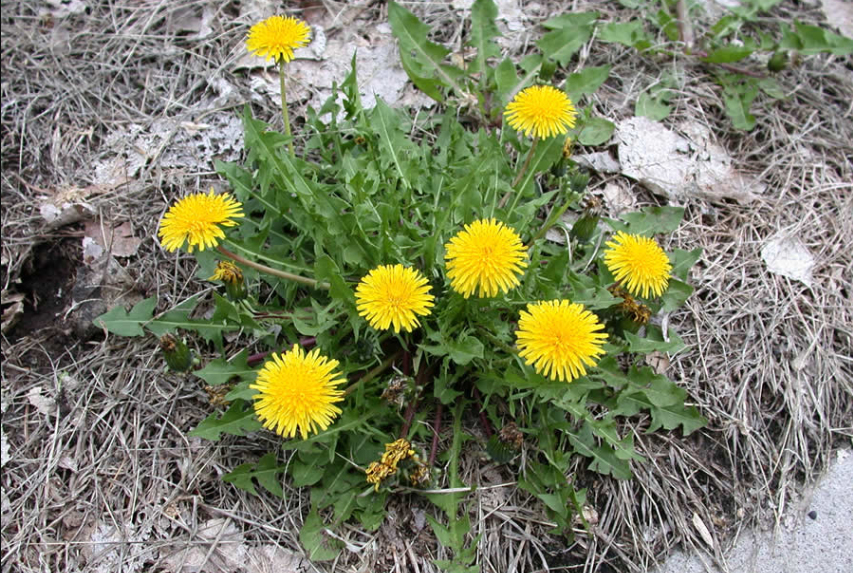
Dandelion (Taraxacum officinale) is a flowering herbaceous perennial plant of the Asteraceae family, commonly known as the dandelion. This plant is native to Europe, Asia, and North America, where it thrives in disturbed habitats. The dandelion is often considered a weed, but it has several culinary and medicinal uses.
Dandelions also have a long history of use in traditional medicine. They have been used to treat infections, digestive symptoms, and as a diuretic. However, it’s important to note that while the use of dandelion in the amounts commonly found in food is generally considered safe, some people may be allergic to it, particularly those who are allergic to related plants like ragweed, chrysanthemums, marigolds, and daisies.
Characteristics
- Perennial: Dandelions are herbaceous perennials, meaning they return year after year, growing from a deep taproot.
- Family: They belong to the Asteraceae family, closely related to daisies, sunflowers, and asters.
- Leaves: The leaves are deeply lobed and have a jagged, toothed edge. They form a basal rosette that lies flat on the ground.
- Flowers: The bright yellow flower head is actually a composite flower made up of many tiny florets. These florets turn into white, fluffy seeds with a parachute-like pappus, allowing the wind to carry them far and wide.
- Height: Dandelions typically grow 4-12 inches (10-30 cm) tall.
Dandelion leaves and flowers can be eaten raw or cooked. They are rich in vitamins A, C, and K, as well as minerals like iron, calcium, magnesium, and potassium. The leaves can be used in salads, stir-fries, jams, wines, and teas. The roots can be dried and roasted to make a coffee substitute. Dandelion flowers can be used to make wine, tea, or jelly.
Dandelions are highly nutritious and contain antioxidants that can help with blood sugar management, skin health, liver health, and heart health. The plant is also rich in fiber, which supports gut health. Additionally, dandelion may help with weight loss by promoting improved carbohydrate metabolism and reducing fat accumulation in the body.
Dandelions are hardy plants that can propagate themselves easily. They have deep taproots and the whole plant contains a milky latex sap. The common name dandelion comes from the French ‘dent de lion’, which translates to “lion’s tooth,” referring to the deep green leaves that are toothed.
Despite being considered a weed by many, dandelions have a significant ecological role. They provide nectar and pollen to honeybees and other beneficial insects, particularly important in early spring when they are one of the only plants in bloom. This makes them a valuable plant for wildlife and a great companion plant for gardening.
Dandelion Leaves
Appearance and Characteristics
- Basal Rosette: Leaves form a basal rosette, radiating out from a central point at ground level.
- Shape and Size: The leaves are deeply lobed with jagged, toothed edges.
- Color: Leaves have a vibrant green color, sometimes with a slight reddish tinge on the veins or edges, especially in younger leaves.
- Texture: The leaves have a slightly bitter taste, which mellows with cooking. The younger leaves tend to be more tender, while older leaves can be tougher.
Nutritional Value
- High in Vitamins: They are an excellent source of vitamins A, C, and K. Vitamin A is crucial for vision and immune function, Vitamin C is a potent antioxidant, and Vitamin K plays a role in blood clotting and bone health.
- Rich in Minerals: The leaves are a good source of minerals like iron, calcium, potassium, and magnesium. Iron is essential for oxygen transport, calcium supports strong bones and teeth, potassium helps regulate blood pressure, and magnesium is involved in various bodily functions.
- Fiber Content: They also contain a good amount of dietary fiber, which aids digestion and promotes gut health.
Culinary Uses
- Salads: Young, tender leaves can be added to salads for a peppery kick and a nutritional boost. Balance the bitterness with sweeter ingredients like fruits or nuts.
- Cooked Greens: Similar to spinach or kale, the leaves can be sauteed, steamed, or boiled. They can be enjoyed on their own or added to soups, stews, and stir-fries.
- Juicing: The leaves can be juiced and combined with other fruits and vegetables for a healthy and refreshing drink.
Dandelion Roots
Structure and Appearance
- Taproot System: Possess a taproot, a single, thick root that grows deep into the soil. This root can reach lengths of several feet (over a meter) in mature plants.
- Color and Texture: The roots are a light brown or tan color on the outside, with a white, fleshy interior. They have a firm, brittle texture and can snap easily when pulled.
Uses of the roots
- Medicinal Uses: Used in traditional medicine for centuries to treat various ailments, including liver problems, digestive issues, and skin conditions. Modern research is ongoing to explore the potential effectiveness of these uses.
- Coffee Substitute: Roasted dandelion root can be used as a caffeine-free coffee alternative. The taste is slightly bitter and nutty.